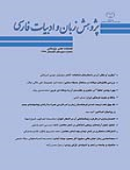مقایسه ساختار حکایت «نظر کردن پیغامبر اسیران را» در مثنوی و فیه ما فیه
محورهای موضوعی : پژوهشهای ادبیات کلاسیک ایران
1 -
کلید واژه: روایتشناسی گفتوگو حکایت اسیران مثنوی فیه ما فیه,
چکیده مقاله :
مطالعات نشان میدهد، در مثنوی معنوی و فیه ما فیه، 12 حکایت مشترک وجود دارد. از آنجا که تحلیل همۀ حکایتهای مشترک در مقالهای واحد امکانپذیر نیست، به نظر میرسد اولین حکایت فیه ما فیه یعنی «نظر کردن پیغامبر اسیران را» که در دفتر سوم مثنوی نیز نظير آن دیده میشود، از بسیاری جهات مانند زمینۀ متن، در هم آمیختن زمینههای تاریخی، کنشها، خلاقیت مولوی و... بیشتر در خور تأمل باشد. مولوی با در آمیختن دو زمینۀ متفاوت جنگ بدر و خندق، دو حکایتی را پدید آورده که در نقشهای آغازین، انواع فرایندهای رفتاری، ذهنی و کلامی مشترکاند؛ امّا در فیه ما فیه با افزودن یک اپیزود، گفتوگوی شخصیتها و در نتیجه برخی نقشها را گسترش داده، و حکایتی متفاوت ساخته است. پژوهش حاضر ضمن بررسی زمینۀ تاریخی حکایت مذکور، به تفصیل، به مقایسۀ کنشها و نقشها و دگرگونی آنها، تحلیل کنشها بر اساس انواع فرایندهای فعلی، بررسی شخصیتها بر اساس دیدگاه گریماس، بررسی جزئیات و ویژگیهای حکایت، صفات و ویژگی شخصیتها، صحنهپردازی و گفتوگوها در فیه ما فیه و مثنوی پرداخته و میزان خلاقیت مولوی یا تصرفات وی را با توجه به ساختار متن نشان داده است.
According to the reviews, there are 12 common narratives in Masnavi and Fih ma Fih. Since analyzing all common narratives is not possible in a single article, it seems that the first narrative of Fih ma Fih named “looking of Prophet at slaves” whose comparable is seen in the third book of Masnavi has many thinkable aspects like context of text, intermixing historical backgrounds, actions, Molavi innovation and so on which makes it more significant. Molavi intermixes two different backgrounds of Badr and Xandagh wars, and creates two narratives which are common in their first roles, kinds of behavioral, mental and verbal processes; but in Fih ma Fih he adds an episode and as a result expands conversation between characters and some roles and makes a different narrative. The current study reviews the historical background of abovementioned narrative, then, compares the actions and roles and their varieties, the analysis of actions based on kinds of current processes, reviewing characters based on the Grimac view, reviewing details and features of the narrative, features and characteristics of characters, scenery, and conversations in Fih ma Fih and Masnavi all in details, and shows the amount of Molavi’s innovation or his occupation based on the structure of the text.

